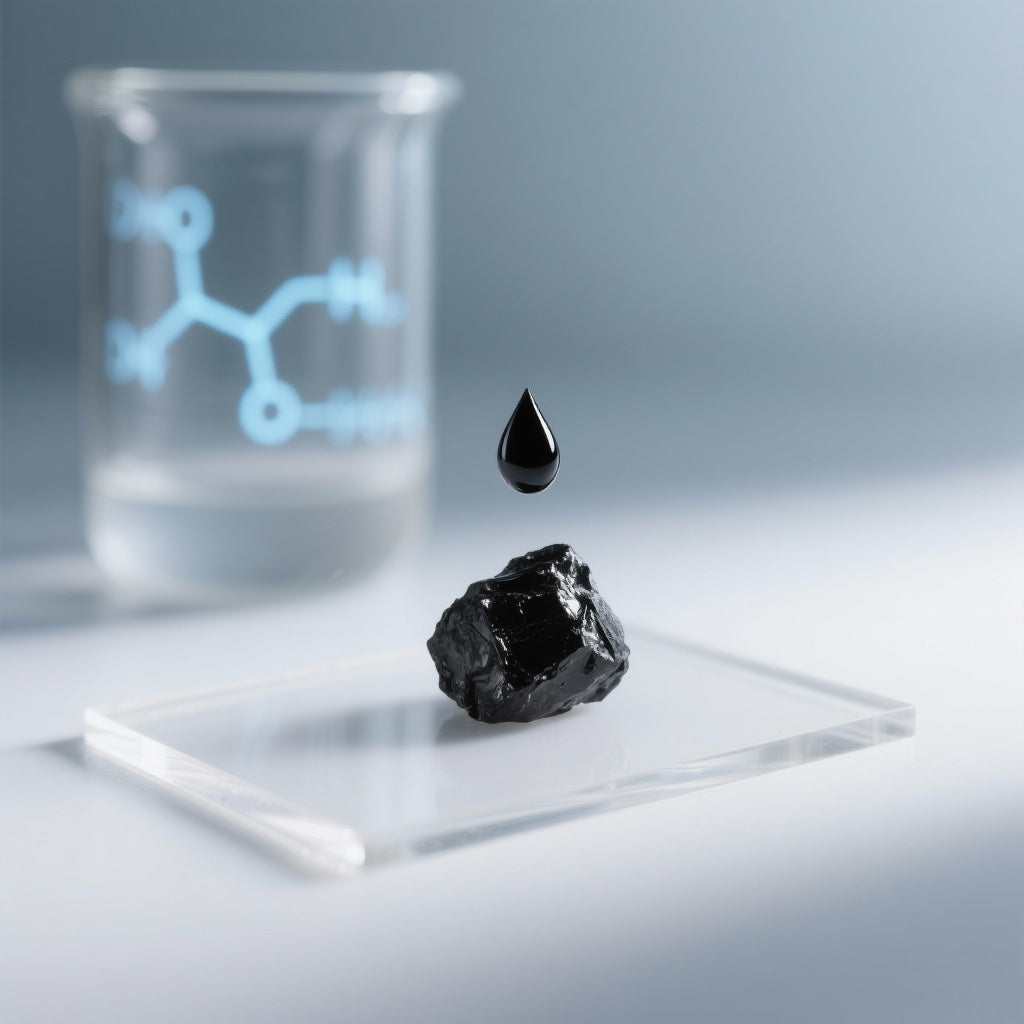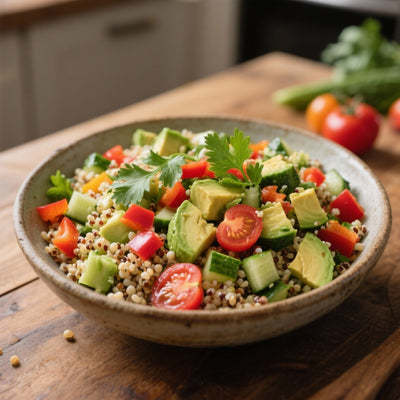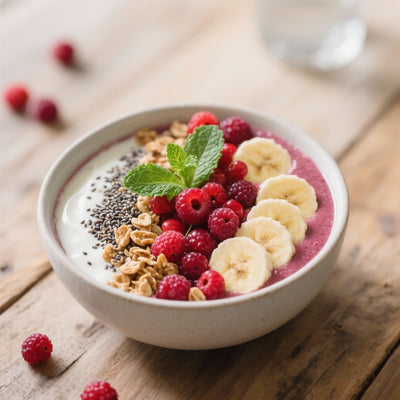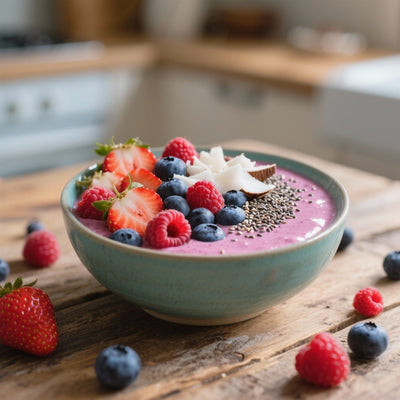What are Dibenzo-α-pyrones (DBP) and why are they the authentication markers of Shilajit?
The wellness market is flooded with "superfoods," each promising renewed vitality. Among them, Shilajit, an ancient resin from the Himalayan mountains, stands out for its legendary reputation. But in a world where imitations are commonplace, how can you distinguish the genuine treasure from a pale copy? The answer lies not in color or texture, but in a molecular signature invisible to the naked eye: Dibenzo-α-pyrones (DBP) .
These unique compounds are more than just ingredients; they are nature's own certificate of authenticity. Understanding the role of DBPs equips you with the knowledge to make an informed choice and invest in a product that truly delivers on its promises. This comprehensive guide will reveal everything you need to know about these biochemical markers, from their millennia-old formation to their crucial importance in guaranteeing the purity and potency of your Shilajit.
The Shilajit: An Ancient Treasure Tested by Modernity
Before delving into the complex chemistry, it's essential to understand what Shilajit is and why its authenticity is so crucial. It's not an herb or a synthetic product, but a rare biogenic substance, the result of a natural process spanning centuries.
What exactly is Shilajit?
Shilajit is a resinous, tar-like substance that oozes from rocks in several mountain ranges in Asia, notably the Himalayas and the Altai. It results from the very slow decomposition of plant matter, including medicinal plants, trapped within the rock layers. Under immense pressure, extreme temperature cycles, and microbial activity, this organic matter transforms over hundreds, even thousands of years, into a dense resin extraordinarily rich in minerals, trace elements, and unique organic compounds.
Considered a cornerstone of Ayurvedic medicine, Shilajit is traditionally used for its ability to rejuvenate the body, increase energy, and improve overall resilience. It is often referred to as the "destroyer of weakness" in Sanskrit.
The Challenge of Authenticity: A Market Saturated with Imitations
The growing popularity of Shilajit has unfortunately led to a parallel market of inferior, even fraudulent, products. Genuine Shilajit is rare and difficult to harvest, making it a valuable commodity. Consequently, many unscrupulous suppliers offer imitations.
"The major problem with Shilajit today is not its effectiveness, but its origin. An uninformed consumer is more likely to come across a counterfeit product, often a mixture of industrial tars or soil extracts with no therapeutic value, than authentic Shilajit."
These counterfeit products not only fail to provide any of the expected benefits, but may also contain heavy metals and other dangerous contaminants. This is where science comes in, offering us a foolproof method of verification: the analysis of Dibenzo-α-pyrones.
Introduction to Dibenzo-α-pyrones (DBP): The Molecular Signature
Imagine a fingerprint so complex that it's impossible to artificially reproduce. That's precisely what Dibenzo-α-pyrones are to Shilajit. These compounds aren't simply "present" in Shilajit; they are living proof of its origin and formation process.
A Unique Chemical Structure Forged by Time
Dibenzo-α-pyrones are a class of metabolic compounds found nowhere else in nature in such concentrations and forms. Their basic structure is a dibenzo-pyrone skeleton, but what makes them unique are the molecules attached to it. Their formation is a slow and complex geological and biological process.
The process begins with specific plants, such as Euphorbia royleana or Trifolium repens , which grow at high altitudes. When these plants die, they decompose and turn into humus. This humus, trapped in rock crevices, is then subjected to decades of pressure and microbial fermentation, which gradually transforms it into the resin we know. These unique conditions allow for the creation of DBP.
DBP Chromoproteins (DCP): The Additional Layer of Security
To add another layer of complexity, the DBPs in high-quality Shilajit are not "free." They are bound to chromoproteins, forming complexes known as DCPs (Dibenzo-α-pyrone Chromoproteins) . These DCPs are the primary carriers of Shilajit's bioactive molecules.
This bond is crucial because it protects DBP from degradation and facilitates its absorption by the body. The presence of DCP is therefore an even more reliable indicator of the authenticity and quality of Shilajit, as this complex is absolutely impossible to synthesize in a laboratory.
DBP as the "Fingerprint" of the Authentic Shilajit
Now that we understand what DBPs are, let's see why they constitute the ultimate test for validating a product. Unlike fulvic acid, which can be found in many sources (such as ordinary soil), DBPs are exclusive to the Shilajit formation process.
Key Fact: Studies estimate that the formation of DBP-Chromoprotein complexes requires a minimum of 40 to 50 years of geological maturation. This guarantees that the product cannot be manufactured quickly or artificially.
The Criteria of an Authentic and Powerful Shilajit
A reputable laboratory doesn't simply look for the presence of DBP. A complete analysis must validate several key points. Here is an ordered list of what defines a first-order Shilajit:
- Confirmed presence of Dibenzo-α-pyrones (DBP): This is the basic criterion. If there is no DBP, it is not Shilajit.
- Adequate concentration of DBP and DCP: Quantity matters. A quality Shilajit should contain a significant percentage of these compounds, generally greater than 0.3%.
- High Fulvic Acid Levels: While not exclusive, a high fulvic acid level (often above 50%) is an indicator of the product's nutrient richness. It acts synergistically with DBP.
- Rich in Ionic Minerals: A complete mineral profile, with more than 84 minerals and trace elements, is essential to the benefits of Shilajit.
- Absence of Contaminants: The certificate of analysis must imperatively show near-zero levels of heavy metals (lead, arsenic, mercury) and microbial contaminants.
Demanding a third-party analysis report (Certificate of Analysis or COA) that verifies these five points is the only way to protect yourself as a consumer.
The Science Behind the Analysis: Demand Evidence
How do companies test for the presence of these molecules? The answer lies in advanced laboratory technologies. Understanding the basics of these tests will help you interpret the reports provided by reputable brands.
HPLC: The Reference Method
The most reliable method for identifying and quantifying bioactive compounds (BACs) is high-performance liquid chromatography (HPLC) . Without going into too much technical detail, this method allows for the separation, identification, and measurement of each component of a mixture. It is an extremely precise technique that can detect BACs even at very low concentrations. A credible Certificate of Analysis (COA) should mention the use of HPLC or an equivalent technique (such as LC-MS) for the analysis of bioactive compounds.
How to Read a Certificate of Analysis (COA)?
A COA may seem intimidating, but you only need to look for a few key pieces of information:
- Laboratory Identity: Ensure that it is an independent third-party laboratory, and not an in-house company test.
- Bioactives section: Look for the lines "Dibenzo-α-pyrones" and "Fulvic Acid". The results must be expressed as a percentage (%).
- Heavy Metals Section: Check that the levels of lead (Pb), arsenic (As), cadmium (Cd) and mercury (Hg) are well below the safety limits (usually expressed in ppm or ppb).
- Batch Number: The COA must match the batch number of the product you are purchasing. Transparent markings make this easy to verify.
Never hesitate to contact a brand to request the Certificate of Analysis (COA) for a specific batch. A company proud of its product will always be happy to share this information.
Beyond Authentication: The Benefits of DBP
Dibenzo-α-pyrones are not simply passive markers. They are at the heart of Shilajit's powerful health effects. Their unique structure gives them remarkable biological properties, which are amplified by the presence of fulvic acid.
The Bioactive Role of DBP
Scientific research has identified several key functions of DBPs and their derivatives in the body:
- Powerful Antioxidants: They are capable of neutralizing free radicals, thus protecting cells from oxidative stress, a key factor in aging and many chronic diseases.
- Cellular Energy Source: DBPs help support mitochondrial function. Mitochondria are the "powerhouses" of our cells. By optimizing their function, Shilajit helps improve energy levels and vitality.
- Immune System Modulators: They can help regulate the immune response, making it more effective without overstimulating it.
- Neuroprotectors: Preliminary studies suggest that DBPs may play a role in protecting brain health.
Essential Synergy with Fulvic Acid
Fulvic acid is Shilajit's "delivery system." This molecule has the unique ability to chelate minerals and other nutrients and transport them across cell membranes. In other words, fulvic acid "captures" the DBP and over 84 trace elements in Shilajit and delivers them directly inside your cells, where they are most needed. Without fulvic acid, many of Shilajit's benefits would be lost.
Frequently Asked Questions (FAQ)
Do all types of Shilajit contain DBP?
No. Only authentic Shilajit, formed over decades from specific plant materials under precise geological conditions, will contain DBP and DCP. Imitations, soil extracts (ozokerite), or low-quality products will not contain them, or only negligible traces.
Does a higher DBP level always mean better quality?
Not necessarily. Balance is key. A good Shilajit should have a significant DBP content (for example, >0.3%), but also a high fulvic acid content and a complete mineral profile. A product that isolates and concentrates only DBP would lose the natural synergy that makes Shilajit so powerful. Nature provides a balanced complex, and it is this balance that should be sought.
Can I test for the presence of DBP at home?
Unfortunately, no. Identifying and quantifying DBPs requires sophisticated laboratory equipment such as HPLC. "In-house" tests (like water solubility or flame tests) can help rule out blatant counterfeits, but they cannot confirm the presence of these essential bioactive compounds. The only guarantee is a Certificate of Analysis (COA) from a third-party laboratory.
Isn't fulvic acid alone sufficient to guarantee quality?
No. Fulvic acid is a vital component, but it can be extracted from many sources, including ordinary soil or lignite. Selling fulvic acid as Shilajit is a common deceptive practice. Only the combined presence of DBP, DCP, and fulvic acid in a rich mineral complex proves that you are dealing with genuine Shilajit.
Your Knowledge, Your Power
You are now armed with invaluable knowledge. Dibenzo-α-pyrones are no longer an obscure scientific term, but your most reliable ally in the quest for pure and potent Shilajit. They represent the geological and biological history of the product, irrefutable proof of its authenticity that neither marketing nor empty promises can replace.
The next time you choose Shilajit, don't just rely on promises. Demand proof. Ask for the certificate of analysis and look for the line that mentions Dibenzo-α-pyrones. By taking this simple step, you ensure you're investing not just in a product, but in a true gift from nature, capable of supporting your well-being in the most profound way.
Ready to discover the power of Shilajit, authenticated by science?
Discover our Pure and Tested Shilajit










